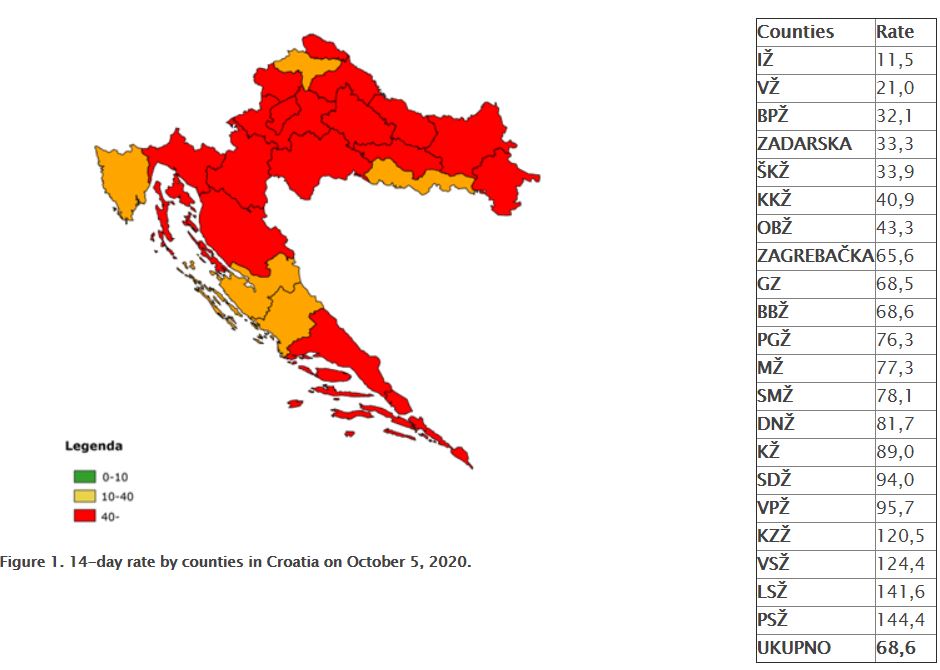Official COVID-19 in Croatia Weekly Report September 29 - October 5, 2020
October 8, 2020 - The latest official COVID-19 in Croatia weekly report has been released by the Koronavirus government website, covering September 29 to October 5.
CIPH report for the previous 7 days and daily report for the Republic of Croatia on the 5th of October 2020.
| Tested | Confirmed cases | Active cases | Recovered | Self-isolation | Hospitalized | On a respirator | Deaths | |
| 328 392 (+2233*) | 17797 (+138*) | 1466 | 16031 | 8923 | 326 | 24 (+3*) | 300 (+2*) | |
| A total of 193 people died in this epidemic wave. Most of the deceased had significant comorbidities or were of advanced age. The average age of the deceased in this epidemic wave is 76.7 years. Ninety - one people died on a respirator. | ||||||||
* in the last 24 hours.
There are currently 24 testing places in the Republic of Croatia that perform RT-PCR analysis and collect samples. All processed samples enter national Croatian Health Insurance Institute platform, which is accessible to all county public health institutes. County public health institutes submit data about positive cases, sources of infection and hotspots as part of their daily reports to the Croatian Institute of Public Health. The Croatian Institute of Public Health collects information about hotspots, hospital treatment of COVID-19 positive persons, COVID-19 positive patients on respirators and the deceased. You can find more about the test centers on the link.
Epidemiological indicators on 5th of October 2020
- Cumulative 7-day rate for the Republic of Croatia: 38,0/100 000
- Cumulative 14-day rate for the Republic of Croatia: 68,6/100 000
- Counties with a cumulative 7-day rate greater than 50/100 000 inhabitants: Krapinsko-zagorska, Ličko-senjska, Međimurska, Požeško-slavonska, Sisačko-moslavačka, Vukovarsko-srijemska
- Counties with a cumulative 14-day rate greater than 100/100 000 inhabitants: Krapinsko-zagorska, Ličko-senjska, Požeško-slavonska, Vukovarsko-srijemska
- Total number of tests in the last week: 32 394
- Share of positive tests in the total number of tests in the last week: 4,8%
- Total number of tests and share of positive tests in total number of tests: 328 392; 5,4%
- The number of new cases in intensive care per 100,000 inhabitants in the last 7 days: 0,46/100 000
- Number of deaths in the last week: 28
- Total death rate per 1 000 000 population: 73,4/1 000 000
Geographical distribution of new COVID-19 cases by counties
In a two-week period from 29th of September to 5th of October all counties recorded new cases of COVID-19 disease. The highest number of new cases are recorded in the City of Zagreb, followed by the Splitsko - dalmatinska and Primorsko - goranska County. The lowest number of new cases were recorded in Istarska and Šibensko - kninska County. The Požeško - slavonska County also has the highest 14-day rate, followed by Ličko-senjska and Vukovarsko-srijemska County.
Figure 1. 14-day rate by counties in Croatia on October 5, 2020.
Epidemic by weeks, from 19th – 32nd week of the epidemic
Table 1 shows the epidemiological indicators by epidemic week. The data shows that one of the most important epidemiological indicators - the rate of confirmed cases and the share of positive ones show a positive trend in the period from 27th to 31st week, while in the 32nd week a slight increase was again recorded. The confirmed case rate has been steadily declining since week 27 when it stood at 47.6 to 31,2 at week 31. The total number of tests has been growing continuously from the 25th week, but at 31st and 32nd week there was a slight decrease in the number of tests compared to previous weeks. The proportion of positive people in total testing also fell steadily, falling from 12.5 in the 26th week of the epidemic to 3.7 in the 31st week to rise again to 4.4% in 32nd week.
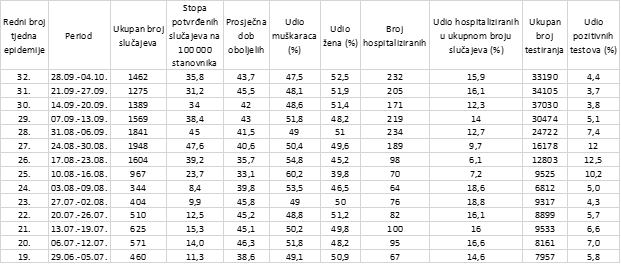
Table 1. Overview of the number of confirmed cases by weeks, from week 19 th – 32nd
Table 2 shows a set of indicators related to the severity of the clinical picture and the characteristics of deaths. The table shows that in the period from 27th to 31st week, there has been an increase, and at 32nd week a slight decrease in the average age of the patients and the number of cases on the respirator, which corresponds to previous findings that older people are more likely to develop more severe clinical forms and higher mortality in older age groups. The death rate in the last 4 weeks shows stagnation.

Table 2. Overview of patients on respirator and deaths by weeks, from week 19th – 32nd
Table 3 shows the incidence of the 7-day rate in the two last weeks with a limit of 50/100 000 inhabitants, which in some countries is taken as one of the criteria in assessing the epidemiological situation. In most counties, the 7-day rate is generally stable or slightly declining, while an increase in the 7-day rate can be seen in counties where outbreaks with a larger grouping of patients have been reported.
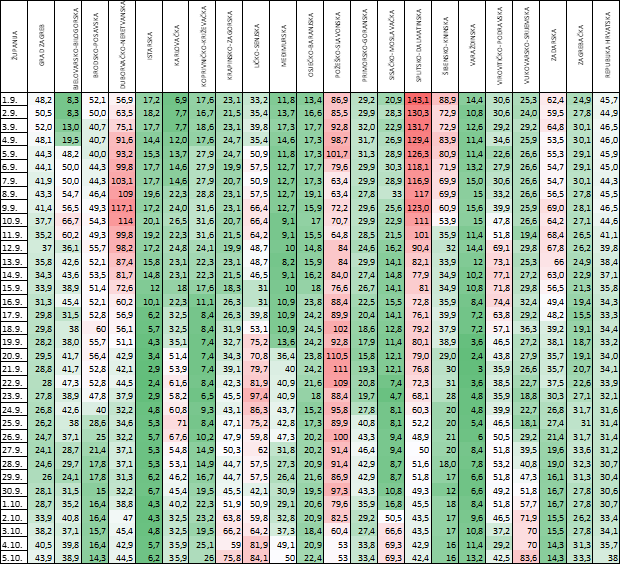
Table 3. Overview of 7-day incidence rates per 100,000 population in the last week
Clinical aspects - Hospitalizations and severity of clinical picture for the period from 29th of September to 5th of October
Figure 2 shows the relationship between the daily number of confirmed cases and the daily number of hospitalized cases. Number of hospitalized cases per day ranged between a minimum of 31 and a maximum of 45, while the share of hospitalized cases in the total daily number of confirmed cases ranged from 12.0% to 32.6%.
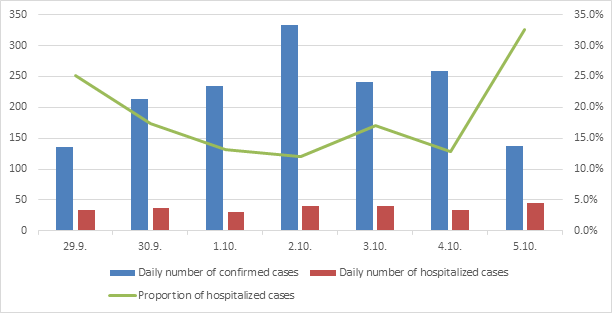
Figure 2. Overview of the daily number of confirmed and hospitalized cases from 29th of September to 5th of October
Figure 3 shows the proportion of hospitalized in the total number of weekly cases. Of the total number of confirmed cases in a given weekly period, 16.8% were hospitalized, which is an increase compared to last week's 15.2%. In the same period, 19 people were put on a respirator, which makes 1,2% of the total number of confirmed cases.
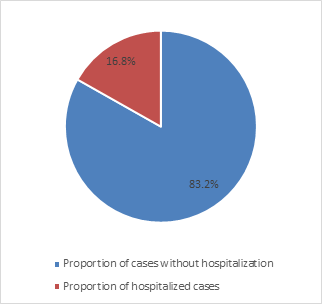
Figure 3. Relation of the total number of confirmed and hospitalized cases (29th of September - 5th of October)
The graph in Figure 4 shows that the slope of the curve of confirmed cases is followed by the curve of cured cases, while the curve of active cases, in addition to some ascending, shows stagnation in certain periods related to the continuation of the first wave of the epidemic in Croatia. After changing the duration of isolation of patients, a sharp decline in the number of active cases is recorded and after that, the number of active cases stagnates.
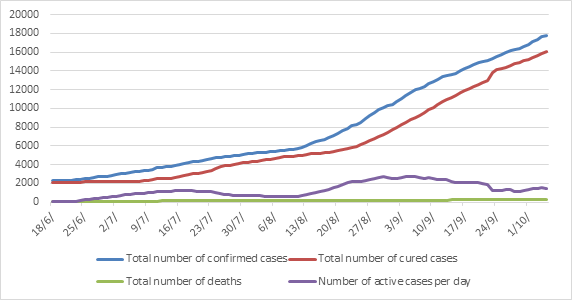
Age-sex distribution of COVID-19 deaths
A total of 193 people died in this wave of epidemics. Most of the people who died had significant comorbidities or were of advanced age. The mean age of the deceased in this wave of epidemics is 76.7 years. Ninety - one people died on a respirator. An overview of the situation is given in Table 4 and Figure 5.
| AGE GROUP | 40-49 | 50-59 | 60-69 | 70-79 | 80-89 | 90-99 | 100+ |
| MEN | 1 | 11 | 20 | 45 | 27 | 8 | 0 |
| WOMEN | 0 | 0 | 14 | 22 | 35 | 9 | 1 |
Table 4. Died people by age and gender in the period from 29th of June till 5th of October
Deaths for the period from 29th of September till 5th of October
In the last week, 28 people died, of which 15 (53.6%) were on a respirator. The distribution by age and sex in the last weeks is shown in Table 5, and by counties in Table 6.
| AGE GROUP | 50-59 | 60-69 | 70-79 | 80-89 | 90-99 |
| MEN | 1 | 3 | 7 | 4 | 2 |
| WOMEN | 0 | 2 | 3 | 4 | 2 |
Table 5. Distribution by age and sex of persons who died in the last week
| County | Number of new cases in the period 29.9.-5.10. | Incidence of new cases in the last 7 days on 100 000 inhabitants | Number of deaths in the period 29.9.-5.10. | Total number of deaths | Total mortality rate at 1,000,000 inhabitants |
| CITY OF ZAGREB | 353 | 43,9 | 6 | 49 | 60,9 |
| BJELOVARSKO-BILOGORSKA | 42 | 38,9 | 1 | 2 | 18,5 |
| BRODSKO-POSAVSKA | 20 | 14,3 | 1 | 6 | 42,8 |
| DUBROVAČKO-NERETVANSKA | 54 | 44,5 | 2 | 15 | 123,7 |
| ISTARSKA | 13 | 6,2 | 0 | 13 | 62,3 |
| KARLOVAČKA | 42 | 35,9 | 1 | 3 | 25,7 |
| KOPRIVNIČKO-KRIŽEVAČKA | 28 | 26,0 | 0 | 16 | 148,5 |
| KRAPINSKO-ZAGORSKA | 95 | 75,8 | 1 | 5 | 39,9 |
| LIČKO-SENJSKA | 38 | 84,1 | 0 | 1 | 22,1 |
| MEĐIMURSKA | 55 | 50,0 | 0 | 0 | 0,0 |
| OSJEČKO-BARANJSKA | 62 | 22,4 | 1 | 27 | 97,4 |
| POŽEŠKO-SLAVONSKA | 36 | 53,0 | 1 | 6 | 88,4 |
| PRIMORSKO-GORANSKA | 95 | 33,4 | 7 | 14 | 49,3 |
| SISAČKO-MOSLAVAČKA | 103 | 69,3 | 2 | 7 | 47,1 |
| SPLITSKO-DALMATINSKA | 190 | 42,4 | 2 | 72 | 160,7 |
| ŠIBENSKO-KNINSKA | 16 | 16,0 | 0 | 7 | 69,9 |
| VARAŽDINSKA | 22 | 13,2 | 0 | 3 | 18,0 |
| VIROVITIČKO-PODRAVSKA | 32 | 42,5 | 1 | 10 | 132,9 |
| VUKOVARSKO-SRIJEMSKA | 129 | 83,6 | 1 | 17 | 110,1 |
| ZADARSKA | 24 | 14,3 | 1 | 9 | 53,5 |
| ZAGREBAČKA | 103 | 33,3 | 0 | 18 | 58,2 |
| TOTAL | 1552 | 38,0 | 28 | 300 | 73,4 |
Table 6. New patients and deaths in the last week and total deaths
Hotspots
Continental Croatia
In the last week, new cases were recorded in all counties of continental Croatia, but mostly in the City of Zagreb, Vukovarsko-srijemska and Sisačko-moslavačka County. The highest 7-day rates on 5th of October were recorded in Vukovarsko-srijemska, Krapinsko-zagorska and Sisačko-moslavačka County. A large increase in the number of patients and a new grouping was recorded in the Sisačko-moslavačka County, where almost all participants in one gathering were positive. These participants also attended various family and public gatherings and a further influx of patients is expected. In Krapinsko-zagorska County, a new large grouping of patients is related to the workplace, but smaller groupings related to the workplace are recorded in several counties. Hotspots related to weddings in Međimurska County and the celebration of the sacraments in Vukovarsko-srijemska County are still active. A smaller hotspot was recorded in the health institution in the City of Zagreb. The disease was also recorded in wards and staff in a home for the elderly in Bjelovarsko-bilogorska, Sisačko-moslavačka and Koprivničko-križevačka County. Some of the patients were imported cases from abroad and a large proportion of the patients came into contact.
Coastal Croatia
Cases of ill persons have been recorded in coastal Croatia like in all counties as well. The highest number of patients was recorded in the Splitsko-dalmatinska, Primorsko-goranska and Dubrovačko-neretvanska County. The highest 7-day rate on October 5th was in Ličko-senjska, Dubrovačko-neretvanska and Splitsko-dalmatinska County. Groupings of patients were recorded in Ličko-senjska County and were associated with two weddings. In the Dubrovačko-neretvanska County, grouping was recorded in the choir of the religious community. Patients are still being recorded in accommodation for the elderly in the Primorsko-goranska County. The disease has also been recorded in the home for the elderly in Ličko-senjska and Zadarska County. As in the Continental Croatia, smaller groupings associated with the spread of the disease in the workplace are recorded. A significant proportion of patients are contacts of previously recorded cases.
Age-sex distribution of patients in the last week
In the previous week, a total of 1552 people fell ill - approximately the same number of females (741 or 47.7%) and males (811 or 52.3%). The same distribution by sex is present in most age groups, except in the age groups under the 11-14 and 15-18 years, where the percentage of ill girls is higher: in the age group 11-14 years 30 girls fell ill (63.8%) and in the age group 15-18 years 55 girls fell ill (60.4%).
By age groups - the least affected were children, 181 (11,7%). Of the children, the youngest patients were younger than 1 year, a total of 3. The most affected were children of high school age, a total of 91.
Adults made the largest share in the total number of patients last week, i.e. 1126 (72.6%). The share of elderly patients is 15.8% or 245 people.
The distribution of patients by age did not change significantly compared to last week, except that the share of elderly patients decreased from 19.3% to 15.8%.
The full view can be found in Figure 6 and Table 7.
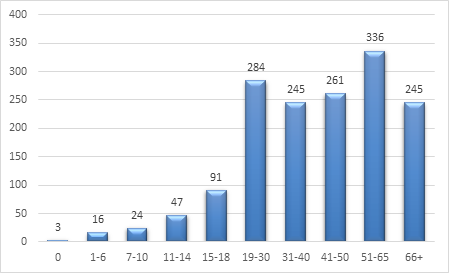
Figure 6. Distribution of patients in the last week by age groups
| Category | Age group | Number of cases men | Share of men (%) | Number of cases women | Share of women (%) | Total by age groups and categories | Share of age groups and categories in the total number of cases (%) | ||
| Kids | 0 | 2 | 66,7% | 1 | 33,3% | 3 | 181 | 0,2% | 11,7% |
| 1-6 | 8 | 50,0% | 8 | 50,0% | 16 | 1,0% | |||
| 7-10 | 11 | 45,8% | 13 | 54,2% | 24 | 1,5% | |||
| 11-14 | 17 | 36,2% | 30 | 63,8% | 47 | 3,0% | |||
| 15-18 | 36 | 39,6% | 55 | 60,4% | 91 | 5,9% | |||
| Adults | 19-30 | 139 | 48,9% | 145 | 51,1% | 284 | 1126 | 18,3% | 72,6% |
| 31-40 | 122 | 49,8% | 123 | 50,2% | 245 | 15,8% | |||
| 41-50 | 122 | 46,7% | 139 | 53,3% | 261 | 16,8% | |||
| 51-65 | 169 | 50,3% | 167 | 49,7% | 336 | 21,6% | |||
| Elders | 66+ | 115 | 46,9% | 130 | 53,1% | 245 | 245 | 15,8% | 15,8% |
| TOTAL | 741 | 47,7% | 811 | 52,3% | 1552 | 100,0% | |||
Table 7. Age and sex distribution of patients in the period from 22nd till 28th of September
Measures
Measures to maintain physical distance, maintain hand hygiene and disinfection are still in force. Also, it is mandatory to wear face masks or medical masks indoors for all health workers and professionals, employees who work in social care system and the ones who work in hospitality facilities.
Headquarters decisions in the previous week:
- Decision amending the Decision about the introduction of necessary epidemiological measures for the area of Ličko-senjska County (October 5, 2020)
- Decision about the introduction of necessary epidemiological measures for the Primorsko-goranska County (October 3, 2020)
- Decision about the introduction of necessary epidemiological measures for the area of the City of Popovača (October 3, 2020)
- Decision about Amendments to the Decision about Introduction of Necessary Epidemiological Measures for the Area of Koprivničko-križevačka County (October 3, 2020)
- Decision about Amendments to the Decision about Introduction of Necessary Epidemiological Measures for the Požeško-slavonska County (October 3, 2020)
- Decision amending the Decision about the introduction of necessary epidemiological measures for the area of Ličko-senjska County (1 October 2020)
- Decision about introduction of necessary epidemiological measures for the area of Šibensko-kninska County (30 September 2020)
- Decision amending the Decision about the introduction of necessary epidemiological measures for the area of Zadarska County (September 29, 2020)
- Decision about amendments to the Decision about introduction of necessary epidemiological measures for the area of Brodsko-posavska County (September 29, 2020)
- Decision about the introduction of necessary epidemiological measures for the area of Vukovarsko-srijemska County (September 29, 2020)
- Decision amending the Decision about the introduction of the necessary epidemiological measure to limit wedding ceremonies for the area of Varaždinska County (September 29, 2020)
- Decision amending the Decision about the introduction of necessary epidemiological measures for the area of područje Dubrovačko-neretvanska County (September 29, 2020)
- Decision amending the Decision about temporary prohibition of crossing the border crossings of the Republic of Croatia (September 29, 2020)
Recommendations and measures on global and EU level
Europe
On 10th of August 2020, ECDC released an updated version of the risk assessment:
- ECDC has additional documents and information available: https://www.ecdc.europa.eu/en, https://www.ecdc.europa.eu/en/covid-19-pandemic
- The number of cases and the 7-day cumulative incidence of COVID-19 confirmed cases worldwide can be found on the ECDC dashboard: https://qap.ecdc.europa.eu/public/extensions/COVID-19/COVID-19.html
Austria
Bundesministerium für Soziales, Gesundheit, Pflege und Konsumentenschutz – https://www.sozialministerium.at/Informationen-zum-Coronavirus/Neuartiges-Coronavirus-(2019-nCov).html
Netherlands
Government of the Netherlands - https://www.government.nl/topics/coronavirus-covid-19
National Institute for Public Health and the Environment - https://www.rivm.nl/en/novel-coronavirus-covid-19Germany
Rober Koch Institut - https://www.rki.de/DE/Home/homepage_node.html
Slovenia
(gov.si) – https://www.gov.si/en/topics/coronavirus-disease-covid-19/
National Institute for Public Health – Slovenia - https://www.nijz.si/en
United Kingdom
gov.uk – https://www.gov.uk/coronavirus
NHS - https://www.nhs.uk/conditions/coronavirus-covid-19/
World
WHO provides comprehensive information and documents
- WHO COVID-19-Dashboard: https://covid19.who.int/
- https://www.who.int/emergencies/diseases/novel-coronavirus-2019
- Coronavirus disease (COVID-19) Weekly Epidemiological Update and Weekly Operational Update i Weekly Surveillance Report: https://www.who.int/emergencies/diseases/novel-coronavirus-2019/situation-reports, https://www.euro.who.int/en/health-topics/health-emergencies/coronavirus-covid-19/weekly-surveillance-report
Sources of information
https://www.hzjz.hr/
https://zdravlje.gov.hr/Information about the global epidemiological situation
More about COVID-19 in other countries can be found and learned on the ECDC website: https://www.ecdc.europa.eu/en/geographical-distribution-2019-ncov-cases. The WHO Regional Office for Europe, the European Commission and the European Observatory on Health Systems and Health Policy have at their disposal the COVID-19 Health System Response Monitor (HSRM). There is information available about European countries and ways to respond to this epidemic. The focus is on health systems and public initiatives: https://www.covid19healthsystem.org/mainpage.aspx
For the latest travel info, bookmark our main travel info article, which is updated daily.
Read the Croatian Travel Update in your language - now available in 24 languages!
Belgium Publishes ''Coronavirus Map'' - 2 Croatian Regions Do Well
October the 8th, 2020 - The Belgian Ministry of Foreign Affairs has published a ''coronavirus map'' which showcases the rate of infection in European countries. Despite Croatia having been placed on the red lists of many countries, it appears that two Croatian regions in particular are doing well when compared to not only the rest of the country, but the rest of the continent.
As Poslovni Dnevnik writes on the 7th of October, 2020, the Belgian ''coronavirus map'' acts as yet another confirmation of the fact that the beautiful region of Istria is not only the best in Croatia in the fight against the spread of the new coronavirus, but it is also among the best in all of Europe, local Istrian portal Glas Istre writes.
The Ministry of Foreign Affairs of the Kingdom of Belgium has published a map of Europe divided into green, light orange, dark orange and red areas. Of all the regions in Europe, only eleven of them are in the lucky colour - green. These are one region in Sweden, four in Poland, two in Bulgaria, two in Italy (Marche and Calabria) and two in Croatia, more precisely Istria and Varazdin counties.
Most of the other Croatian regions are in orange on Belgium's coronavirus map, and in the unfortunate colour of red are the counties of Split-Dalmatia, Karlovac, Lika-Senj and Pozega-Slavonia. Belgium has no travel restrictions, but, depending on the colour, travel is either recommended or not recommended unless necessary. However, returning from the red areas involves testing and quarantine, and this isn't the case when returning to Belgium from any of the others.
Within Croatia, Istria has the fewest cases, in the last 14 days only cumulatively around 6 new cases per 100,000 inhabitants, which is excellent indeed.
For the latest travel info, bookmark our main travel info article, which is updated daily.
Read the Croatian Travel Update in your language - now available in 24 languages
Coronacrisis has Changed Consumer Habits, Accelerated Online Shopping
ZAGREB, Oct 7, 2020 - The crisis caused by the Covid-19 pandemic has changed consumer habits and accelerated online shopping, it was heard at the 32nd edition of the MAGROS 2020 conference for producers and retailers organized by the Croatian Chamber of Commerce (HGK) and the Suvremena Trgovina (Modern Shopping) magazine.
Economy Ministry State-Secretary Natasa Mikus Zigman underlined that retail is important for economic development, supporting her claim with data on the share of distributive retail trade-in GDP of 10% and that 18% of all business entities are incorporated in that sector that employs 204,000 people or 15% of the total number of workers.
During the pandemic online shopping increased which shows, she said, that digital transformation is coming at an accelerated rate.
However, Mikus Zigman underlined that traditional shopping should not be neglected as it is a key element for economic growth, particularly for local communities and for consumers who do not use digital technology and all those people who prefer the traditional way of shopping.
HGK vice president for retail and finances, Josip Zaher, said that "we are living in very challenging and uncertain times in the midst of the global coronavirus pandemic but all restrictions can also be a challenge and an opportunity."
"At the beginning of the year already we expected retail to grow in the overall economy, with tailwinds being provided by the record 2019 year, which after 11 years reached the level of retail of 2008. However, restrictions due to the pandemic have resulted in tectonic disruption on the global level and that downturn was felt in consumption and a change in habits by consumers hence in March a fall in retail was recorded after continually growing for five and a half years," said Zaher.
According to the State Bureau of Statistics (DZS), in the first eight months of the year retail contracted by 6.9%, compared to the same period last year, said Zaher, noting that recovery is not expected to occur next year and online shopping and adapting to new business conditions will continue.
He underlined that the ten strongest retailers account for 80% of the market which is very competitive as can be seen with the arrival of Eurospin in the midst of the pandemic. "Despite that, we do not expect any significant rearrangements on the market," said Zaher.
Online shopping increase by 14%
Head of HGK's retail section Tomislava Ravlic pointed out the permanent growth in online shopping which according to DZS, increased by 13.9% in the first six months of the year. "That trend was certainly boosted by the pandemic which restricted physical shopping," she underlined.
She too said that consumer habits are changing with more people turning to online shopping because of the coronavirus. Household appliances, IT equipment, clothing, and footwear are the most common products bought online with an increase in online food sales too, said Ravlic.
For the latest travel info, bookmark our main travel info article, which is updated daily.
Read the Croatian Travel Update in your language - now available in 24 languages
Croatian Plant Sweet Wormwood Treats Coronavirus, say German Scientists
October 7, 2020 - Medical professionals remain cautious, but German media reports that scientists in their country have evidence to suggest Sweet Wormwood is effective in treating COVID-19. Known as Slatki Pelin in Croatia, the plant grows in Dalmatia and Herzegovina
67-year-old German media outlet Deutsche Welle has written that scientists within their country have discovered that Sweet Wormwood is effective in treating COVID-19. The plant is known as Slatki pelin in Croatian and grows wild within inland Dalmatia and nearby Herzegovina. Sweet Wormwood is known as Slatki pelin in Croatia and grows in Dalmatia and Herzegovina, where people have been using it in tea as a herbal remedy © Stefan.lefnaer
Sweet Wormwood is known as Slatki pelin in Croatia and grows in Dalmatia and Herzegovina, where people have been using it in tea as a herbal remedy © Stefan.lefnaer
Scientists from the German Max-Planck Institute in Potsdam are researching how to treat patients with the plant. Though the World Health Organisation says there is currently no evidence that sweet wormwood helps in the treatment of COVID-19, Dr Andrea Jurić, acting director of the Institute of Public Health of West Herzegovina Canton, confirmed to Deutsche Welle that she was aware of the plant's positive effects on COVID-19 patients within Herzegovina. Some of the region's inhabitants have been using the plant to make tea for use as a herbal remedy for those who have COVID-19. Herbal remedies are commonly used across Bosnia and Herzegovina.
When asked about the German media report, Croatian Minister for Health Krunoslav Capak said that no comment could be made without recognised clinical trials having first been undertaken. “We in the medical profession are primarily guided by scientific research and clinical trials of drugs and medical procedures,” he said, after reminding journalists early reports that chloroquine and some other antiviral drugs were successful in treating COVID-19 had since been disproved by clinical trials. “Only when something is proved to be useful can we talk about it.”
Sweet Wormwood or Artemisia annua in Latin, is also sometimes known as Sweet Annie, Sweet Sagewort, Annual Mugwort and Annual Wormwood. It grows naturally in North America and in Asia too. In China, it has long been used in herbal medicine and is widely cultivated for that purpose. The plant already has an established reputation for combating malaria. Sweet Wormwood © Kristian Peters
Sweet Wormwood © Kristian Peters
For the latest travel info, bookmark our main travel info article, which is updated daily.
Read the Croatian Travel Update in your language - now available in 24 languages.
Join the Total Croatia Travel INFO Viber community.
363 New Coronavirus Cases and 5 Dead Reported in Croatia
ZAGREB, Oct 7, 2020 - Over the past 24 hours 363 new coronavirus cases have been registered in Croatia, bringing the number of active cases to 1,830, and five persons have died, the national COVID response team said on Wednesday.
Currently, 344 patients are hospitalized, including 26 on ventilators, while 9,675 persons are self-isolating.
Since February 25, when the first infection was registered in Croatia, 18,447 persons have been infected with the virus, of whom 309 have died, while 16,308 have recovered, including 116 in the last 24 hours.
To date, 338,594 persons have been tested, including 5,353 in the last 24 hours.
For the latest travel info, bookmark our main travel info article, which is updated daily.
Read the Croatian Travel Update in your language - now available in 24 languages
Excellent Epidemiological Situation: 'Istria is Again an Example to The Rest of Croatia!'
October 6, 2020 - According to the latest data, only one case of coronavirus infection has been recorded in Istria today. In the past two weeks, only 13 cases have been recorded, which puts this Croatian region in the green zone according to the criteria of the European Union, reports Hina.
Last week, from September 28th to October 4th, 2020, Istria recorded eight new cases, and a week earlier only five. As of October 5, Istria had no cases of coronavirus infection and only 9 active cases of infection, which is the lowest number of cases when compared to other counties, reports Jutarnji.
The excellent epidemiological situation in Istria was also announced by the Mayor of Pula, Boris Miletić, on his Facebook page, where he posted a photo showing that Istria is the only 'green' zone in Croatia.
“Istria is again an example to the rest of Croatia! Bravo Istrians!” the mayor wrote below the photo.
At the same time, neighboring Primorje-Gorski Kotar County and Slovenia have a more difficult situation and record numbers of newly infected people.
The head of the Epidemiology Service of the Institute of Public Health of the Istrian County, Dr. Jasna Valić, consciously said that "the situation in Istria is still good and stable, but that can change overnight."
"We are aware that the coming months will not be easy and that is why we once again appeal to the citizens to be responsible and careful. Of course, we all hope that there will be no 'clogging' of the health care system, which is already happening in Spain, France, and Italy, which are again on the verge of complete closure," said the leader.
In Novigrad, there has been recorded a case of infection of a kindergarten teacher, which is why self-isolation measures were determined for 120 children and 30 employees of a preschool institution on Saturday, October 3rd, 2020.
Istria had a relatively good epidemiological situation during the pandemic, which is why they appealed to other countries to decide to put it on the red list according to the regions of Croatia, and not the whole country.
For the latest travel info, bookmark our main travel info article, which is updated daily.
Read the Croatian Travel Update in your language - now available in 24 languages
Chief Epidemiologist Says Masks will have to be Worn Indoors, at Bus Stops
ZAGREB, Oct 6, 2020 - Masks will have to be worn in all indoor spaces as well as outside where close contact cannot be avoided, such as tram and bus stops, Krunoslav Capak, head of the Croatian Institute of Public Health and a member of the national COVID response team, said on Tuesday.
"Wearing masks is certainly useful and will be introduced for indoor spaces, as well outside where close contact can't be avoided in the form of a recommendation," he told the press.
Representatives of the response team have talked with bar and restaurant owners about wearing masks in their establishments and they have no objections. This would not apply while drinking or eating, but while arriving or leaving, going to the toilet and to have a cigarette, Capak said.
He said new rules on wearing masks indoors were being discussed as part of preparations for the cold part of the year and other respiratory infections, adding that contacts with the Croatian Bishops' Conference and bar and restaurant owners would continue.
Regarding possible fines, Capak said bar and restaurant owners were for stepping up inspections so that those owners who complied with the measures did not suffer.
He dismissed today's media reports about a death threat he received. "I did receive a death threat but a month ago, when I reported it to the police who are investigating. I cannot comment on that."
Regarding the upcoming skiing season, Capak said skiing in itself was not risky but that travel, staying in hotels, cafes and night clubs or riding in gondolas with 50 people was. "We epidemiologists do not recommend some things that are risky."
Minister: Wearing masks says we are responsible
Speaking at the same press conference, Health Minister Vili Beros too underlined the importance of wearing masks in fighting coronavirus, saying that, depending on the epidemiological situation, wearing them would be recommended in other circumstances as well.
He said many additional measures were being considered and that they would be activated as required.
Keeping a physical distance is the most reliable way of stopping the spread of coronavirus, but there are circumstances when that isn't possible, he said. "Then a mask is extremely important. A mask says that we are responsible, primarily towards others and less towards ourselves."
2 to 12 Protest: Zagreb Caterers Closing for One Hour on Thursday
October 6, 2020 - Zagreb caterers will close for one hour on Thursday to continue the countdown warning of the difficult situation their businesses are in due to the coronavirus pandemic.
HRTurizam reports that on Thursday, October 8, starting at 11:58 am, Zagreb caterers will suspend service in their catering facilities to warn of the difficult situation they are in due to the coronavirus pandemic and to encourage urgent action by responsible institutions to preserve jobs and prevent the collapse of the economy.
This protest is named "2 to 12" and is continued by the Independent Association of Caterers (Zagreb) to save the fate of thousands of employees in the sector and encourages citizens and caterers to show solidarity.
Encouraged by the devastating survey results on the operation of catering facilities in 2020 and the lack of reaction from responsible institutions after numerous appeals from caterers, the Independent Association of Caterers (Zagreb) with the support of the National Association of Caterers and the Voices of Entrepreneurs Association launches the "2 to 12" protest in the Croatian capital, which has over 4,500 facilities.
Caterers are looking for tax relief with a level of taxation that is realistic and paves the way for recovery. They ask the responsible institutions to suspend the collection of VAT until March 1, 2021, a permanent preferential rate on food - which according to the Food Act includes food, coffee, beer, juices, water, and wine - of 10%, access to HAMAG BICRO credit lines for liquidity and HBOR for investments,
Zagreb's situation is particularly difficult because, in addition to the devastation caused by the coronavirus pandemic, Zagreb was affected by the first major earthquake in the last hundred years, said Marin Medak, president of the Independent Association of Caterers.
"We are aware that problems cannot be solved overnight, but we are also obliged to warn of justified fears for our own existence. We believe that the Government will take a step forward and accept the call for dialogue. Deputy Prime Minister and Minister of the Interior Davor Bozinovic recognized the caterers' appeal and started talks on the application of future anti-epidemic measures with the experts. After the action of Bjelovar caterers called "3 to 12", the mayor of Bjelovar took everything in his domain to protect his fellow citizens and entrepreneurs. We expect the same from other departments key to the work of caterers and related activities, which together generate 320 thousand jobs," said Medak.
The caterers point out that all the problems accumulated before the pandemic are now being charged.
The doubling of VAT in the hospitality industry that suddenly followed on January 1, 2017, brought many to the brink of profitability. If the Government does not listen this time, the pandemic will eventually put the key in the lock for many. They say that the inherited problems and new business obstacles have forced them to act together and increasingly warn the Government of the shortcomings on the ground.
"Measures to preserve CES jobs will help caterers who saw a drop of 60% or more in turnover than the same period last year. However, what about us who have a drop of 59% or less?" emphasizes Damir Jurkovic, vice president of the Independent Association of Caterers.
"That is why we are looking for clearer and more efficient models for allocating funds for maintaining liquidity. We are not asking for free money, but access to credit lines for our employees' salaries and lower taxes to repay loans. With the highest tax rate on the preparation and serving of beverages in Europe, it is not possible to plan business in the future," says Jurkovic.
A sample survey of almost 500 caterers from all over Croatia found that almost 60% of them recorded a decline in business by more than 50%, and almost 40% face the fact that, in these conditions, they will not survive until next season. As many as 80% of employers will be forced to resort to terminating contracts with employees.
For the latest travel info, bookmark our main travel info article, which is updated daily.
Read the Croatian Travel Update in your language - now available in 24 languages!
Join the Total Croatia Travel INFO Viber community.
Croatia Confirms 287 New Coronavirus Cases, 4 Deaths in Last 24 Hours
ZAGREB, Oct 6, 2020 - A total of 287 new coronavirus cases have been registered in Croatia in the last 24 hours, bringing the total number of active cases to 1,588, the national coronavirus response team said on Tuesday.
Among the active cases are 334 people who are receiving hospital treatment for COVID-19, of whom 24 are on ventilators.
Four infected people have died in the last 24 hours.
Since February 25, when the first case was confirmed in Croatia, 18,084 people have been infected with the novel virus, of whom 304 have died and 16,192 have recovered, including 161 in the last 24 hours. A total of 9,610 people are currently self-isolating.
To date, 333,241 people have been tested, including 4,849 in the last 24 hours.
Working From Home Erases Line Between Working Hours and Private Time - Round Table
ZAGREB, October 5, 2020 - The Bridge party organised a round table on Monday on the topic "Working from Home: Do we have the right of disconnect", which discussed amendments to the Labour Act due to the coronavirus, where a lot of people work from home and the line between working hours and private time disappears.
The discussion was organised following announcements that changes would be made to the Labour Act. A lot of workers work from home due to the coronaviurs situation and in many cases have to work more and need to be available all the time.
"It has been seen in practice that work from home often leads to an overlap between working hours and private time and that the fine line is being moved or erased completely," president of the Independent Croatian Unions, Kresimir Sever, said.
He explained that an employee's working hours with an employer are clearly defined, but if that employee starts working from home, a good portion of employers abuse that and expect employees to work a lot more, leaving less time for leisure activities.
"Until such time that that system is put in order, we cannot talk about real remote work," said Sever.
He added that times of crises are not a good time to amend laws.
"Laws should not be adapted to crisis situations, but should be regulated during normal times, emphasising that a crisis may occur," he said.
He warned that the crisis situation is being exploited to introduce a more flexible labour system in Croatia which is unacceptable for the unions, and all under the guise that remote work has to be regulated.
"The Labour Act is extremely flexible in Croatia. It allows employers a wide spectrum to arrange labour relations. The thing that would provide real flexibility is collective bargaining and there is very little of that in Croatia," Sever believes.
Viktor Gotovac from the Labour and Social Law Department at the Faculty of Law does not agree that the law is good as it does not regulate remote working.
"That means that the law is not good. We have student contracts, employing pensioners, author's contracts, everything just not to change the law... I worked form home after the earthquake and my employer immediately cut off my travel allowance, but I was not paid for using my own premises, resources," Gotovac underlined.
He did not agree that the coronavirus caused the problem but rather pointed out what needs to be changed for a better legislative framework which would regulate wages, working hours and leave.
For the latest travel info, bookmark our main travel info article, which is updated daily.
Read the Croatian Travel Update in your language - now available in 24 languages


